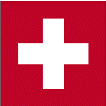|
Switzerland
|

|
Capital: Bern
Population: 8,591,365
Brief History of Switzerland:
Switzerland was originally inhabited by Celtic tribes. In the 1st century BC, Rome conquered the land and Switzerland was a Roman province for 500 years. The area flourished under Roman rule with roads being built between major cities allowing for trade and commerce to grow.
In 800, the Frankish Empire under Charlemagne took control of Switzerland. For many years the country would be part of the Holy Roman Empire. In 1291, the families of Unterwalden, Schwyz, and Uri signed a charter making Switzerland an independent country. Formal independence wasn't gained from the Holy Roman Empire until 1499.
Switzerland aimed to become a neutral country and to not be involved in any wars. However, Napoleon still invaded the country in 1797. However, after Napoleon was defeated, the Congress of Vienna in 1815 gave Switzerland the status of permanent armed neutrality. Switzerland was able to maintain their neutrality through both World Wars and the Cold War despite being centrally located.
The Geography of Switzerland
Total Size: 41,290 square km
Size Comparison: slightly less than twice the size of New Jersey
Geographical Coordinates: 47 00 N, 8 00 E
World Region or Continent: Europe
General Terrain: mostly mountains (Alps in south, Jura in northwest) with a central plateau of rolling hills, plains, and large lakes
Geographical Low Point: Lake Maggiore 195 m
Geographical High Point: Dufourspitze 4,634 m
Climate: temperate, but varies with altitude; cold, cloudy, rainy/snowy winters; cool to warm, cloudy, humid summers with occasional showers
Major cities: Zurich 1.143 million; BERN (capital) 346,000 (2009)
The People of Switzerland
Type of Government: formally a confederation, but similar in structure to a federal republic
Languages Spoken: German (official) 63.7%, French (official) 20.4%, Italian (official) 6.5%, Serbo-Croatian 1.5%, Albanian 1.3%, Portuguese 1.2%, Spanish 1.1%, English 1%, Romansch 0.5%, other 2.8% (2000 census)
Independence: 1 August 1291 (founding of the Swiss Confederation)
National Holiday: Founding of the Swiss Confederation, 1 August (1291)
Nationality: Swiss (singular and plural)
Religions: Roman Catholic 41.8%, Protestant 35.3%, Orthodox 1.8%, other Christian 0.4%, Muslim 4.3%, other 1%, unspecified 4.3%, none 11.1% (2000 census)
National Symbol: Swiss cross (white cross on red field; arms equal length)
National Anthem or Song: Schweizerpsalm [German] Cantique Suisse [French] Salmo svizzero, [Italian] Psalm svizzer [Romansch] (Swiss Psalm)
Economy of Switzerland
Major Industries: machinery, chemicals, watches, textiles, precision instruments
Agricultural Products: grains, fruits, vegetables; meat, eggs
Natural Resources: hydropower potential, timber, salt
Major Exports: machinery, chemicals, metals, watches, agricultural products
Major Imports: machinery, chemicals, vehicles, metals; agricultural products, textiles
Currency: Swiss franc (CHF)
National GDP: $353,600,000,000
** Source for population (2012 est.) and GDP (2011 est.) is CIA World Factbook.
Back to Geography Home Page
